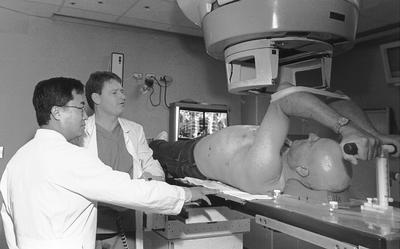New therapy increases lung cancer survival rates

Dr. Hak Choy (left) and radiation therapist Ben Welch examine patient Jessie Jeter. Choy is investigating a new lung cancer treatment regimen that is showing positive results. Photo by Donna Marie Jones.
A combination of two chemotherapy drugs given along with radiation therapy can improve survival among advanced lung cancer patients, a Vanderbilt Cancer Center researcher and his colleagues have found.
In a multi-center trial, researchers investigated the drug paclitaxel and carboplatin given in conjunction with radiation therapy to patients with advanced non-small cell lung cancer. Survival rates were 61 percent at one year and 40 percent at two years, an improvement over standard therapy, said Dr. Hak Choy, associate professor of Radiology and Radiological Sciences and clinical director of the Center for Radiation Oncology.
"This study, along with other studies, shows a two-year survival of about 40-50 percent," said Choy, who with his colleagues has been studying the radiation-enhancing qualities of paclitaxel over the past five years.
"Before the days of paclitaxel, two-year survival was 20-25 percent, so it's an improvement, especially when you consider that lung cancer patients, on average, traditionally survive only about a year. When you also consider that there are 200,000 lung cancer patients every year, even a small increase in survival can make a difference for a large number of people."
Choy, the study's principal investigator, presented his most recent findings last month at the annual meeting of the American Society of Clinical Oncology (ASCO), the single largest meeting of oncologists in the United States. This year's meeting drew 14,000 attendees to Denver in May.
Choy and his colleagues in lung cancer research are doing their work against a backdrop of significant progress in the war on cancer. The National Cancer Institute recently reported that the overall death rates from cancer have peaked and begun to decline.
Major advances have been made in treatment for lung cancer that are improving survival and quality of life for patients. Even so, it remains the No. 1 cancer killer of men and women ‹ and a perplexing challenge for scientists and clinicians fighting the disease.
Since the mid-1980s, lung cancer deaths overall have begun to level off after a dramatic 30-year increase, according to NCI data.
That decline in the overall death rate is due, in great measure, to changes in smoking patterns, but those smoking trends do not bode equally well for all segments of the population. While smoking has decreased among men since 1965, it has increased among women, and smoking is also on the rise among teen-agers.
In addition, about 20 percent of lung cancer occurs in non-smokers, and people who have stopped smoking continue to have an increased risk of developing lung cancer for a number of years.
So the need for improved therapies exists in tandem with the need for prevention efforts, VCC researchers say.
Based on laboratory data that suggested paclitaxel could enhance the effects of radiation, Choy and his colleagues initiated a clinical trial in 1992 combining the drug with radiation therapy in patients with advanced non small-cell lung cancer.
"We found a two-year survival of about 35 percent," Choy said. "So the study that we presented at ASCO went a step further, to give paclitaxel and carboplatin along with radiation in the same patient population."
Patients received six weeks of the standard daily radiation, combined with weekly doses of the two drugs. This concurrent therapy was followed by two additional chemotherapy cycles.
The VCC is now conducting a subsequent trial that uses twice-daily radiation combined with weekly chemotherapy with both drugs. That trial is being conducted at the VCC as well as 12 hospitals throughout Tennessee, Kentucky and Alabama that are part of the VCC Affiliate Network.
One-year survival data will not be available until the fall, but so far, the results look impressive, said Choy.
The next step in this line of research will be to launch a randomized, multi-center trial that will compare different regimens of paclitaxel -carboplatin-radiation combinations, Choy said. The study is being designed to involve some 40 facilities, mostly community hospitals, and will enroll more than 400 patients.
"Once these studies have finished, we hope to know that the paclitaxel -carboplatin combination is truly better," Choy said.













